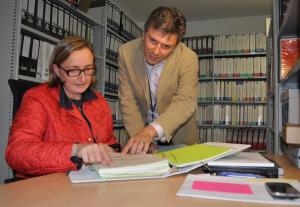Preserving the "living memory" of ITER
8 Oct 2010
-
Robert Arnoux
"The Knowledge Preservation Plan will become a permanent fixture of ITER life," says Document Control Section Leader Daniele Parravicini, here with his assistant Sybille Villareal.
Some 45 years from now, after ITER has completed its scientific program and the installation has been dismantled, nothing will remain—except of course the project's legacy as the "largest international scientific collaboration" in the history of mankind.
With the living memory fading and the physical traces erased, the archived documents will be all that is left to explore the history of the project and render its evolution intelligible for future generations.
However far away, this future is being prepared today.
Already, the early ITER and "proto-ITER" paper documents that were produced in San Diego, Naka and Garching, some dating back to the mid-1970s, have been collected, inventoried, and safely stored in adapted temperature and hygrometric conditions—some 30 cubic metres of printed material, video tapes and floppy discs that lay in storage near the Riviera city of Nice.
Their inventory is now online and a scan of any of these million-plus documents can be ordered and delivered in the form of a PDF file in less than 24 hours.
As the day-to-day production of the Organization, now mainly digital, is being processed, converted into a dedicated format for long-term archiving (PDF/A) and stored in the "centralized repository" of the ITER Document Management (IDM) system, a plan is ongoing to preserve the information that never finds its way into printed matter.
"Since the Organization was established, important people have made important decisions," explains ITER Document Control Section Leader Daniele Parravicini. "Some of these people are already gone, some will soon be, and we think it is important to preserve the traces of their decision-making process, of their perceptions and emotions ..."
A part of the recently-implemented Knowledge Preservation Plan aims at just that. Members of the Communication Team recently sat with former Director-General Kaname Ikeda and taped a long interview that shed interesting light on the tenure of ITER's first Director-General.
Once transcribed, this document will be made searchable and available to staff on the integrated computing platform in use at ITER, together with more multimedia material.
The same operation will be conducted with other key people who have left the Organization. As Parravicini puts it: "The Knowledge Preservation Plan will become a permanent fixture of ITER life."
"The feeling of history," he adds, "is rarely there at the beginning of an Organization ..." People have to deal with the daily demands of their job and rarely place their actions in a 'historical' perspective.
The Knowledge Preservation Plan encompasses much more than interviewing ITER "old hands" when they leave the Organization.
An "integral part of the ITER Organization," the Plan follows the IAEA definition of knowledge management and knowledge preservation: it is "an integrated, systematic approach to identifying, acquiring, transforming, developing, disseminating, using, sharing, and preserving knowledge, relevant to achieving specified objectives; [it] helps an organization to gain insight and understanding from its own experience."
The "knowledge" that is preserved through such an approach is made of many things: know-how and technicity of course, but also feelings, memories, joys and pains. It is the memory of a living organization.


